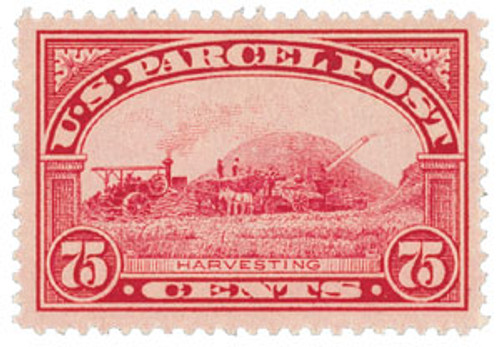
1913 15c Parcel Post Stamp,Automobile Service
# Q7 - 1913 15c Parcel Post Stamp - Automobile Service
$8.50 - $765.00
U.S. #Q7
1912 15¢ Automobile Service
Parcel Post
Issue Date: 1913
City: Washington, DC
Quantity: 21,147,033
Printing Method: Engraved
Perforations: 12
Color: Carmine rose
City: Washington, DC
Printing Method: Engraved
Perforations: 12
Color: Carmine rose
In 1912, the U.S. Postal Department introduced parcel post service for sending items weighing 16 ounces or more through the mail. The mail is divided into four classes, with parcel post making up the fourth class. Almost any type of merchandise can be mailed parcel post, including day – old chicks, baby alligators, and honeybees. Only items that could be dangerous to handle cannot be sent through Parcel Post. Rural Americans used the new mail class to access goods and merchandise they could not have gotten before, giving rise to mail order giants like Sears, Roebuck and Co. and Montgomery Ward and Co.
Twelve stamps with various denominations were issued in 1912-13 to prepay the fourth-class rate. The four Parcel Post stamps with denominations of 5¢, 10¢, 15¢, and 20¢ featured transportation of the mail. Although different vignette designs were featured, all twelve stamps used the same border and color, which caused a great deal of confusion for postal workers.
The 15¢ Parcel Post Stamp
This 15¢ stamp pictures a mail carrier with a full sack of mail going to his mail car. These cars replaced the horse-drawn wagons for delivery vehicles. The stamp was issued on November 27, 1912 and, almost 22 million of these stamps were printed.
Because of the confusion over the stamps, the Postmaster General authorized the use of ordinary postage for parcel post. Parcel post stamps were valid for all classes of mail until the supply was depleted.
U.S. #Q7
1912 15¢ Automobile Service
Parcel Post
Issue Date: 1913
City: Washington, DC
Quantity: 21,147,033
Printing Method: Engraved
Perforations: 12
Color: Carmine rose
City: Washington, DC
Printing Method: Engraved
Perforations: 12
Color: Carmine rose
In 1912, the U.S. Postal Department introduced parcel post service for sending items weighing 16 ounces or more through the mail. The mail is divided into four classes, with parcel post making up the fourth class. Almost any type of merchandise can be mailed parcel post, including day – old chicks, baby alligators, and honeybees. Only items that could be dangerous to handle cannot be sent through Parcel Post. Rural Americans used the new mail class to access goods and merchandise they could not have gotten before, giving rise to mail order giants like Sears, Roebuck and Co. and Montgomery Ward and Co.
Twelve stamps with various denominations were issued in 1912-13 to prepay the fourth-class rate. The four Parcel Post stamps with denominations of 5¢, 10¢, 15¢, and 20¢ featured transportation of the mail. Although different vignette designs were featured, all twelve stamps used the same border and color, which caused a great deal of confusion for postal workers.
The 15¢ Parcel Post Stamp
This 15¢ stamp pictures a mail carrier with a full sack of mail going to his mail car. These cars replaced the horse-drawn wagons for delivery vehicles. The stamp was issued on November 27, 1912 and, almost 22 million of these stamps were printed.
Because of the confusion over the stamps, the Postmaster General authorized the use of ordinary postage for parcel post. Parcel post stamps were valid for all classes of mail until the supply was depleted.















